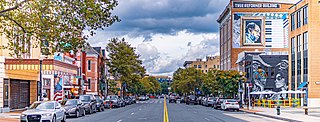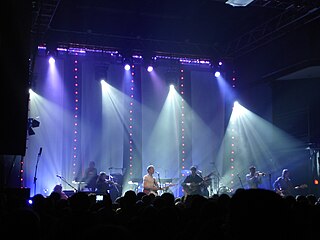
Washington, D.C., has been home to many prominent musicians and is particularly known for the musical genres of Jazz, Rhythm & Blues, bluegrass, punk rock and its locally-developed descendants hardcore and emo, and a local funk genre called go-go. The first major musical figure from District of Columbia was John Philip Sousa, a military brass band composer. Later figures include jazz musicians, such as Duke Ellington, Charlie Rouse, Buck Hill, Ron Holloway, Davey Yarborough, Michael A. Thomas, Butch Warren, and DeAndrey Howard; soul musicians, including Billy Stewart, The Unifics, The Moments, Ray, Goodman & Brown, Van McCoy, The Presidents, The Choice Four, Vernon Burch, guitarist Charles Pitts, and Sir Joe Quarterman & Free Soul.

The Black Cat is a nightclub in Washington, D.C., located on 14th Street Northwest in the Shaw/U Street neighborhood. The club was founded in 1993 by former Gray Matter drummer Dante Ferrando, along with a group of investors and quickly established itself as a venue for independent music. While the Black Cat is most known for its support of indie rock, featured musical acts include metal, punk, and electronic, as well as DJ/dance nights.

The 9:30 Club is a nightclub and concert venue in Washington, D.C. In 2018, the 9:30 Club was named one of the 10 best live music venues in America by Rolling Stone, and in 2019 the club was named "Venue of the Decade" by VenuesNow.

Shaw is a neighborhood of Washington, D.C., located in the Northwest quadrant. Shaw is a major entertainment and retail hub, and much of the neighborhood is designated as a historic district, including the smaller Blagden Alley-Naylor Court Historic District. Shaw and the U Street Corridor have historically have been the city's hub for African-American social, cultural, and economic life.

The U Street Corridor or Greater U Street, sometimes known as Cardozo/Shaw, is a neighborhood in Washington, D.C., located in Northwest D.C. Centered along U Street, the neighborhood is one of Washington's most popular nightlife and entertainment districts, as well as one of the most significant African American heritage districts in the country.

Petworth is a neighborhood of Washington, D.C., located in Northwest D.C. While largely residential, Petworth is home to a notable commercial corridor of shops and restaurants, primarily along Georgia Avenue and Upshur Street, as well as a portion of 14th Street. The neighborhood is accessible via the Georgia Ave–Petworth station on the Green Line of the Washington Metro.

Blues Alley, founded in 1965, is a jazz nightclub in the Georgetown neighborhood of Washington, D.C.
The Cellar Door was a 163-seat music club located at 34th & M Street NW in the Georgetown neighborhood of Washington, D.C. from 1964 through January 7, 1982. It occupied the location of a former music club called The Shadows.

Lincoln Theatre is a historic theater in Washington, D.C., located at 1215 U Street, next to Ben's Chili Bowl. The theater, located on "Washington's Black Broadway", served the city's African American community when segregation kept them out of other venues. The Lincoln Theatre included a movie house and ballroom, and hosted jazz and big band performers such as Duke Ellington. The theater closed after the 1968 race-related riots. It was restored and reopened in 1994, and hosts a variety of performances and events. The U Street Metro station, which opened in 1991, is located across the street from the Lincoln Theatre.

The culture of Washington, D.C. is reflected in its status as the capital of the United States and the presence of the federal government, its large Black population, and its role as the largest city in the Chesapeake Bay region. The presence of the U.S. federal government, in particular, has been instrumental in developing numerous cultural institutions throughout the city, such as museums and performing arts centers. The city's historic Black population has also helped drive cultural activities and artistic pursuits. During the early 20th century, for example, Washington's U Street Corridor became an important center for African American culture.

The Turf Club is a bar, restaurant and music venue in Saint Paul, Minnesota, United States.

A jazz club is a venue where the primary entertainment is the performance of live jazz music, although some jazz clubs primarily focus on the study and/or promotion of jazz-music. Jazz clubs are usually a type of nightclub or bar, which is licensed to sell alcoholic beverages. Jazz clubs were in large rooms in the eras of Orchestral jazz and big band jazz, when bands were large and often augmented by a string section. Large rooms were also more common in the Swing era, because at that time, jazz was popular as a dance music, so the dancers needed space to move. With the transition to 1940s-era styles like Bebop and later styles such as soul jazz, small combos of musicians such as quartets and trios were mostly used, and the music became more of a music to listen to, rather than a form of dance music. As a result, smaller clubs with small stages became practical.

Mazza Gallerie was an upscale shopping mall which was demolished in 2023 and is currently being rebuilt as a mixed-use development It is located along Connecticut Avenue in the Friendship Heights neighborhood of northwest Washington, D.C. at the Maryland border. Opened in 1977, it had 300,000 square feet (28,000 m2) of retail space on three levels, a parking garage, and a direct connection to the Friendship Heights station of the Washington Metro. The last retail business closed in December 2022. The building is to be converted to residential apartments with retail on the ground floor.
The Cavern Club at 10 Mathew Street, in Liverpool was the venue where the Beatles' UK popularity started. John Lennon, Paul McCartney, George Harrison and Pete Best were first seen by Brian Epstein at the club. Epstein eventually became their manager, going on to secure them a record contract. Best was replaced by Ringo Starr on 16 August 1962, which upset many Beatles fans. After taunts of, "Pete forever, Ringo never!", one agitated fan headbutted Harrison in the club.

The Cavern Club is a music venue on Mathew Street, Liverpool, England.

The Krazy Kat Klub—also known as The Kat and Throck's Studio—was a Bohemian cafe, speakeasy, and nightclub in Washington, D.C. during the historical era known as the Jazz Age. Founded in 1919 by portraitist and scenic designer Cleon "Throck" Throckmorton, the back-alley establishment functioned as a speakeasy after the passage of the Sheppard Bone-Dry Act in March 1917 by the United States Congress that imposed a ban on alcoholic beverages in the District of Columbia. Within a year of its founding, the club became notorious for its riotous live performances of hot jazz music which often degenerated into mayhem.

U Street Music Hall was a dance club and live music venue founded in 2010 and located in the U Street Corridor of Washington, D.C. Artists and DJs booked at U Street Music Hall spanned the spectrum of electronic music, including house, disco, techno, bass and electro. It is often referred to as "U Hall".
DC9 Nightclub is a nightclub and restaurant in the Shaw neighborhood of Washington, D.C. It is known for its indie music scene, dance parties, and karaoke. DC9 has a capacity of 250 people and is a venue for live music and DJs.
















